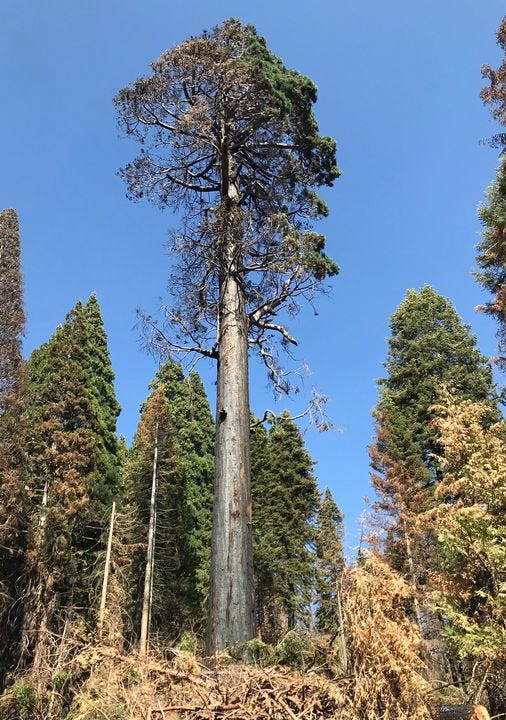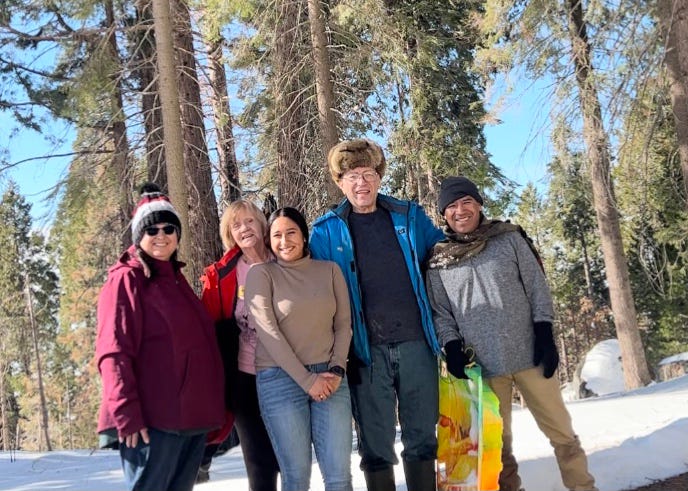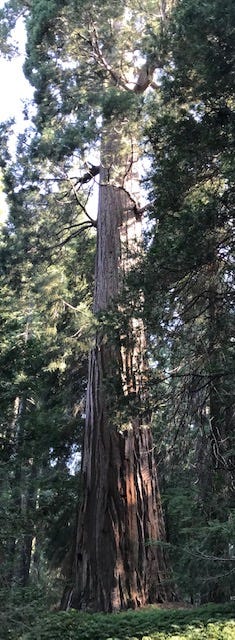How many more victims will the Castle fire take?
‘Each year there seem to be fewer branches of green on top’
Volume 1, Number 29 - Thursday, Feb. 23, 2023
Now twice a week — Monday and Thursday mornings!

This week’s spotlight
By Claudia Elliott
Giant Sequoia News
FOR 38 YEARS, John and Freda Walser have admired the ancient giant sequoia tree growing next to their home in Sequoia Crest, a community about 40 miles northeast of Porterville, California.
They bought the mountain home in 1985 and were told at the time that the tree was about 1,500 years old. The monarch is only about a mile away from the famous Amos Alonzo Stagg Tree, the fifth largest tree in the world and one of the tallest giant sequoias.
In 2020, the tree next to the Walser home was severely scorched in the Castle fire. Officials have reported that the fire killed between 10 and 14 percent of all large giant sequoias growing in the Sierra Nevada. The same fire destroyed 46 of 102 homes in Sequoia Crest.
Their home was spared, but in mid-February, John Walser said the tree is likely to become another victim of the fire.
“Each year there seem to be fewer branches of green on top,” he said. “We are hoping for regrowth, but getting discouraged.”
The Walser home was built by a previous owner in the late 1960s. Building lots in Sequoia Crest were promoted as an opportunity to “own-a-redwood” and eventually five different subdivisions of about 150 acres created about 200 lots, of which just more than half were built on by the time the Castle fire ripped through the neighborhood.
“I don’t believe any homes were slightly burned, but all 46 went down to merely ashes,” Walser said in a recent interview. “One is rebuilt completely, one is almost completed and the rest are just rumors at this time.
“The area around the mailboxes is called downtown and my house is all that survived in that immediate area. I don’t think anything will be built around me since it is just bare, stump-covered ugly ground. We were lucky to have only lost seven or eight trees on the fringes of our property.”
But the apparently dying huge tree next to their home may eventually have to be taken down, too.
And in addition to the change in the scenery, Walser noted that the loss of the trees has changed the microclimate. Without the shade from the trees, summer days are warmer and the couple had to install air conditioning. “Because so many trees were lost, the high winds that used to be elevated off the ground, are now at ground level and are a bit scarier,” he added.
Such changes are among additional challenges in reforestation because even if giant sequoia seeds sprout, they can’t survive in the changed environment making natural regeneration of areas hit by severe wildfire unlikely.
When the Walsers bought their mountain home in 1985, they were living in Santa Barbara. In 1988, they moved to a small ranch near Porterville and transitioned to full-time at Sequoia Crest in 1995. Even before the Castle fire they were among a handful of full-timers with most of their neighbors using the homes as vacation properties.
Castle fire
The Castle fire was discovered on Aug. 19, 2020, in the Golden Trout Wilderness, about 10 crow miles east of Sequoia Crest. It eventually merged with the Shotgun fire, another lightning-caused fire to the north, and the inferno became known as the SQF Complex fire. It burned primarily on Sequoia National Forest including in 12 giant sequoia groves, and also crossed into Sequoia National Park. In addition to the homes lost in Sequoia Crest, Tulare County's Fire Chief reported 50 destroyed structures in nearby Alpine Village and 46 in Cedar Slope, another small mountain community about 9 miles away. The fire burned through the end of the year, encompassing more than 174,000 acres.
For more than two weeks, the Walsers hunkered down at home, enduring smoke and regularly checking for news of the fire. They left early in the morning of Sept. 4 and went to Ponderosa Lodge, about 15 miles southeast.
“Hours later we were told to leave by the back exit, through California Hot Springs,” Walser recalls. Instead of heading down Highway 190 toward Porterville, they were routed south along the Western Divide Highway. The road travels the ridge that separates the Kern River and Tule River drainages. From Hot Springs they then traveled to Porterville to stay with friends.
“We returned Nov. 4 to no electricity for three weeks,” Walser said. “Internet and phone came two or three weeks after that. It was still great to be home.”
By that time, work to clear hazard trees — those that were obviously dead and at risk of falling — had already begun in Sequoia Crest. Workers used a crane to help cut dead branches off of trees. And Tulare County officials worked to help property owners get assistance with clearing debris.
A storm brought snow not long after the Walsers returned home and the precipitation aided firefighting efforts. But the SQF Complex fire wasn’t officially contained until Jan. 5, 2021, and a giant sequoia tree torched by the fire was found still burning four months later.
“I heard one fool say the firefighters put resources in the wrong place and could have prevented some of the damage,” Walser said. “Hindsight is always better, but sometimes you have to guess based on the information you have at the time. I believe the firefighters acted bravely and are all heroes.”
Forest management
As long-time residents, the Walsers had been through wildfires before, including the McNally fire of 2002. Before the Castle fire, the 150,696-acre McNally had been the largest fire in the region. And remaining residents were evacuated again in September 2021 when the area was threatened by the 97,528-acre Windy fire — which burned through 11 giant sequoia groves.
As a mountain resident, Walser has been to plenty of meetings having to do with fire safety and related topics through the years.
“I haven’t seen any proper forest management in the 38 years I have owned this home,” he said. “The Forest Service makes sensible recommendations about firebreaks and fire safety and the Sierra Club and money-controlled legislature veto those plans. Needless to say, we did not have sufficient firebreaks.”
In the summer of 2022, the Forest Service launched what it called emergency action to remove fuels from giant sequoia groves in an attempt to help protect them from what many believe is inevitable fire. By reducing the fuels — literally cutting and removing brush and trees around monarch giant sequoias — the agency hopes to reduce the severity of the wildfires that are likely to burn in the future.
Save the Redwoods League
The Rouch family developed Sequoia Crest in the 1960s and owned another 530 acres adjacent to the subdivision until December 2019 when the land was purchased by Save the Redwoods League.
At the time, the environmental organization said the tract of land was the largest remaining privately owned giant sequoia property in the world. In addition to the Stagg tree and other monarchs of the Alder Creek grove, the property had robust stands of mature red fir, white fir, ponderosa pine and sugar pine and a range of habitats.
The organization’s plan was to eventually pass the land along to the Forest Service to become part of Giant Sequoia National Monument. That is still the plan, according to the organization’s website.
But the land and grove have greatly changed since the Castle fire.
“In areas that were impacted by low- to moderate-severity fire, the forest and meadows are still healthy, hundreds of ancient sequoias remain standing, and some seedlings have sprouted in low-severity burn areas,” according to the organization. “However, in some areas, severe fire destroyed the forest canopy and giant sequoia cones and seeds, as well as damaged the soil, meaning these areas cannot recover on their own and reforestation will be needed.”
Meanwhile, Walser is keeping an eye on that tree next to his home. He said he doesn’t think he’s met anyone from Save the Redwoods League, but has received letters and emails from the organization that owns and manages land just down the road from his house. He said he thinks they seemed condescending, “as if they were our personal saviors.”
A miracle
At 78, Walser knows he’ll never see the area as it was before the fire. But he’s glad for the many years he and his wife enjoyed living among the mammoth trees.
“Which houses burned and which survived makes absolutely no sense to anyone up here,” Walser said of the neighborhood locals refer to as The Crest. “The only thing we all agree on is that my house surviving was a miracle. When the burn line is five feet from the side of your house and every house on all sides was lost, it is time to thank God.”

Wildfire, water & weather update
Severe weather outlooks like this one have been posted for areas where giant sequoia grow as a series of cold storms moves through California.
Drought update: A new California drought map will be released later today, probably not much different from last week’s.
Wildfire update: Nothing new to report, but Wikipedia is ready for California’s wildfire season with this PAGE.
Did you know you can comment here?
It’s easy to comment on items in this newsletter. Just scroll down and you’ll find a comment box. You’re invited to join the conversation!
Giant sequoias in the news
• The U.S. Fish and Wildlife Service has determined that the California spotted owl is comprised of two geographically and genetically distinct population segments and is proposing to list the Coastal-Southern California DPS as endangered and the Sierra Nevada DPS as threatened under the Endangered Species Act. READ more here (and I’ll write more about what this may mean for giant sequoias in an upcoming edition.
• The National Park Service (NPS) is seeking public feedback on a proposal to replant giant sequoia and other mixed conifer seedlings in areas severely impacted by the recent Castle and KNP Complex wildfires and where regeneration is otherwise not anticipated in Sequoia and Kings Canyon National Parks. Read about it HERE and consider participating in the virtual meeting from 5 to 6 p.m. on Feb. 27.
• Kyle Jacobson is the new Forest Fire Management Officer on Tahoe National Forest, home of the Placer Big Trees giant sequoia grove.
• If the weather is getting you down, check this VIDEO out — it’s called “an ethereal timelapse of Sequoia National Park. The trees never fail to inspire!
A work in progress —
The Big Trees & The Presidents
My friend Gary Adest of River Ridge Ranch got me thinking about the relationship between presidents of the United States and giant sequoias when I saw him last fall. I knew, of course, that President Bill Clinton established the Giant Sequoia National Monument in 2000. And that President George H. W. Bush had visited Sequoia National Forest in July 1992 to sign a proclamation protecting the naturally occurring giant sequoia groves within the Sequoia, Sierra and Tahoe National Forests.
But further research showed many other historic ties between the chief executive of our country and treasured giant sequoias.
I decided that exploring those ties would help me better understand what I think of as the political history of these special trees.
Readers of the Thursday edition of this Giant Sequoia News can preview this book as it is written because I plan to post excerpts of the work in progress here in the coming weeks (and months).
Please remember, everyone needs an editor and I’m flying solo here. So if you spot errors — from typos to content — I hope to hear from you.
This week we begin at the beginning…
Introduction
Studying the relationship between presidents of the United States and Sequoiadendron giganteum — the giant sequoia tree native to California — provides an opportunity to better understand the country's environmental politics. And understanding those politics is integral to charting a course to protect the iconic trees.
But before we consider the relationship of presidents of the United States with giant sequoias, we must understand the heritage of the land on which these treasured trees grow.
Our purpose here is not to explore the natural history of the Sierra Nevada — the mountain range that dominates Central California and the natural range of existing groves of giant sequoia trees — although that is a worthy endeavor. Nor will we consider the first people who knew these majestic trees, people native to the land who lived in the Sierra Nevada for more than 10,000 years (even longer than the oldest giant sequoias), because we have little record of their interaction with the big trees.
Instead, our story begins around 1830, about 20 years before California became part of the United States.
In 1830, the lands on which giant sequoia trees grow were part of the Republic of Mexico. We have no evidence of exploration of the Sierra Nevada by either Mexican citizens of the day or representatives of the King of Spain, who claimed the territory and controlled at least part of it before Mexico gained independence from Spain in 1821 — 45 years after the 13 colonies of the United States declared their independence from Great Britain.
In those years — between 1776 and 1821 — the United States had only five presidents. These were George Washington, John Adams, Thomas Jefferson, James Madison and James Monroe. John Quincy Adams became president on March 4, 1825, after Mexican independence.
It's hard to imagine today, but news about Mexico's independence from Spain did not reach Alta California until a year later. The political climate of the next two decades set the stage for war between the two young countries.
Spanish explorers left few records about the interior of California and apparently did not set foot in the Sierra Nevada. Franciscan missionary Pedro Font named the range — the "snowy mountains" he could see from a distance — on a map created in 1777. There were explorations into the foothill country east of present-day Visalia, but not into the higher elevations nearby where the Spanish could have seen vast groves of giant sequoias. Under Mexican rule, Alta California had little attention.
But even before California became a territory in 1848, mountain men, including American Joseph R. Walker, began to explore the interior.
Historians credit Walker's party, in 1833, as the first non-native people to see the giant sequoias of the Sierra Nevada. Scribe Zenas Leonard called the trees "red wood" or "redwood." He wrote they were "incredibly large — some of which would measure from 16 to 18 fathoms round the trunk at the height of a man's head from the ground." Researchers believe the trees he described were in the Merced or the Tuolumne Grove of modern-day Yosemite National Park.
But it was not until 1852 — after California was part of the union and during the famous Gold Rush — that a man named Augustus T. Dowd was chasing a bear and discovered 90 or so massive trees growing in what is now known as the Calaveras Grove.
News of the unbelievably large trees soon spread around the world.
You can guess what happened next — men headed to the woods to cut the trees down.
A dozen years later, what is considered to be the first law to protect California's giant sequoias was passed by Congress and signed by President Abraham Lincoln. But that action didn't mean the federal government would care for that land. It would be eight years before the first national park — Yellowstone — was established.
However, the Yosemite Valley Grant Act, signed by the president on June 30, 1864, gave the Mariposa Grove of giant sequoias and Yosemite Valley to the state of California "upon the express conditions that the premises shall be held for public use, resort, and recreation."
The act passed during the Civil War, and Lincoln hoped to see the mammoth trees for himself someday. Less than a year later, however, the president was assassinated.
And more than 150 years later, the trees remain in peril. Acts of Congress and presidential proclamations can't stand up to extraordinary wildfires or drought. Land ownership and rules and regulations can only provide so much protection. Scientists don't always agree. And politicians have agendas of their own.
From Abraham Lincoln to Joe Biden, U.S. presidents have impacted the fate of giant sequoias. The National Park Service tells us that more than 85 percent of all giant sequoia grove acreage across the Sierra Nevada burned in wildfires between 2015 and 2021 — compared to only one quarter in the preceding century. All or part of the presidencies of Barack Obama, Donald Trump and Joe Biden were in those years.
Certainly, giant sequoias have not been the only topic of concern for these or other presidents. But the iconic trees are known around the world. And the story here is how they fit into the history of the U.S. and its leadership. — Claudia Elliott
Thanks for reading!






Thanks for posting. It’s heartbreaking to lose homes so glad his was saved. I live in the Sierra east of Fresno & barely survived the creek fire which decimated the area so my heart goes out to anyone who lost their home. Regarding Save the Redwoods League has anyone seen this site ( I have NO affiliation but have seen the same myself & the FS has used similar tactics in my area)?
https://www.ilovetrees.net/save-the-redwoods-logging-continues/
If this is true is that what we really think will “save the Forest”? Clear cuts & roundup in our pristine water seems the opposite of what is needed. We can all mostly agree on what we want so I’d love to see the focus on solutions to combat climate change & prescribed burns which the vast majority agree to vs more cutting & chemicals. Regardless appreciate the site!
Interesting read from a local homeowner's perspective.